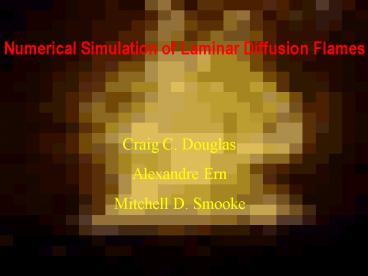Numerical Simulation of Laminar Diffusion Flames - PowerPoint PPT Presentation
1 / 33
Title:
Numerical Simulation of Laminar Diffusion Flames
Description:
Flame Treatment of Polymer Films. Combustion of Solid Rocket ... Flame Sheet Model. Adds only one field to the underlying ... of Laminar Diffusion Flames ... – PowerPoint PPT presentation
Number of Views:426
Avg rating:3.0/5.0
Title: Numerical Simulation of Laminar Diffusion Flames
1
Numerical Simulation of Laminar Diffusion Flames
Craig C. Douglas Alexandre Ern Mitchell D. Smooke
2
- Goals
- Model high heat release combustion problems
- Predict the effects of combining chemical
reactions with heat and mass transfer phenomena
3
Improving Jet Engine Efficiency
4
Improving Combustion and System
EfficienciesTurbulent Combustion
5
Improving CombustionCompact Waste Incinerator
6
Flame Treatment of Polymer Films
7
Research Projects
- Combustion of Solid Rocket Propellants
- Microgravity Combustion of Structural Metals
- Combustion-Generated Air Pollution
- Air Quality Impacts of Alternative Fuels and
Reformulated Gasoline - Effects of Subsonic Aircraft Emissions on
Chemistry in the Upper Troposphere
8
Turbulent Premixed Flame
9
(No Transcript)
10
Axisymmetric Laminar Diffusion Flames
- Flame type of several combustion devices
- Complications
- Large number of dependent unknowns
- Governing partial differential equations are
nonlinear - Different length scales due to regions of high
activity
11
Flame Sheet Model
- Adds only one field to the underlying flow fields
- Greatly reduces cost of computer simulations
- Coupling and nonlinearity features are the same
in both models - Temperature and major species profiles can be
obtained from a conserved scalar equation
12
Physical Configuration
13
Formulations of the Navier-Stokes Equations
- Streamfunction-Vorticity
- eliminates pressure as a dependent variable
- reduces the number of equations by one
- continuity is explicitly satisfied locally
- accurate vorticity boundary conditions are hard
to specify - results in ill-conditioned Jacobians
- does not reasonably extend to 3 dimensions
- Primitive Variable
- Vorticity-Velocity
14
Formulations of the Navier-Stokes Equations
- Streamfunction-Vorticity
- Primitive Variable
- easily extendible to three dimensions and
unsteady problems - allows for accurate boundary conditions
- staggered grid creates problems for multi-grid
solvers and in complex geometries - Vorticity-Velocity
15
Formulations of the Navier-Stokes Equations
- Streamfunction-Vorticity
- Primitive Variable
- Vorticity-Velocity
- allows for more accurate vorticity boundary
conditions than streamfunction-vorticity - yields better conditioned Jacobians
- uses nonstaggered grids
- extends easily to three dimensions
16
Notation
17
Notation
18
Notation
19
Diffusion Flame Governing Equations
Radial Velocity
Axial Velocity
Vorticity
20
Additional Equations
Equation of State
Shvab-Zeldovich Equation
21
Boundary Conditions
Axis of Symmetry
Outer Zone
Inlet
Exit
22
Solution
Grid
Dependent Variables
Nodes
23
Finest Grid
Coarsest Grid
24
- Spatial Operators finite
differences - Diffusion and Source Terms centered
differences - Convective Terms monotonicity
preserving upwind scheme
(1)
25
- Boundary conditions - first order back or forward
differences - Exceptions
- vorticity inlet boundary condition
- axial velocity boundary condition at r 0
(2)
(3)
(4)
26
Discretization of the partial differential
equations and boundary conditions yield nonlinear
equations
The equations are solved using a damped Newton
method
(5)
Convergence tolerance
27
- Algorithms
- Bi-CGSTAB/GS
- GMRES/GS
Parabolic Problem
(6)
28
Multigrid Methods
- One Way Multigrid
- course grid problem is solved and the solution is
interpolated onto the next finer grid as an
initial guess - time relaxation process only on coarsest level
29
Multigrid Methods
- Damped Newton Multilevel Multigrid
- makes use of Jacobians computed at all levels
coarser than the current level - significantly faster than one way multigrid
- requires 62 Mb of storage as compared to 39 Mb
for the one way multigrid
30
(No Transcript)
31
(No Transcript)
32
Numerical Results
33
Sources
Douglas, C. C., and A. Ern, Numerical Solution
of Flame Sheet Problems with and without
Multigrid Methods, in Sixth Copper Mountain
Conference on Multigrid Methods, N. D. Melson, T.
A. Manteuffel, and S. F. McCormick, eds., vol. CP
3224, Hampton, VA, 1993, NASA, pp.
143-157. Douglas, C. C., A. Ern, and M. D.
Smooke, Multigrid Solution of Flame Sheet
Problems on Serial and Parallel Computers,
1994. Douglas, C. C., A. Ern, and M. D. Smooke,
Numerical Simulation of Laminar Diffusion Flames,
1994. Ern, A., Vorticity-Velocity Modeling of
Chemically Reacting Flows, PhD Thesis, Yale
University, February 1994. Mechanical and
Engineering Department. Ern, A., C. C. Douglas,
and M. D. Smooke, Detailed Chemistry Modeling of
Laminar Diffusion Flames on Parallel Computers,
1994.
34
Numerical Solution of Laminar Diffusion Flames
35
(No Transcript)































